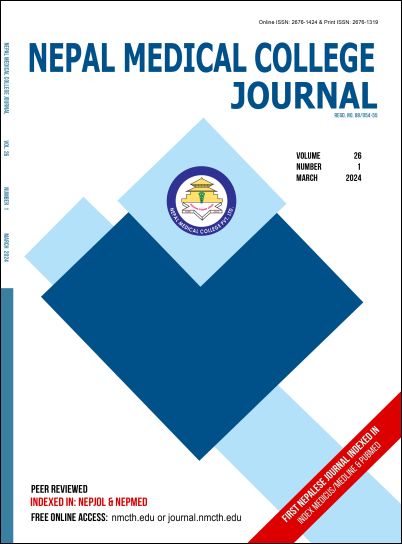Laser Lithotripsy for the Management of Ureteric Calculus
DOI:
https://doi.org/10.3126/nmcj.v26i1.63888Keywords:
Ureteric calculus, laser lithotripsy, retropulsion, Double J stent, Xray KUB, ultrasound, stone free rateAbstract
Urinary calculi are important problem in urology field. Ureteral stones can cause obstructive uropathy and subsequent deterioration of renal function. The minimal invasive approaches become the major source of treatment modalities with the development of lithotripsy technology. A prospective cross sectional hospital study was conducted in the Urology Department of a tertiary care hospital in Kathmandu for a period of one year (September 2022 to August 2023). A total of 118 patients attending Urology OPD and undergoing laser lithotripsy were included in the study. Ureteroscopic procedure was done using a 6.5 Fr (Wolf Inc., Germany) semirigid ureteroscope under direct endoscopic vision and once the stone was visible, fragmentation was done using Ho-YAG laser. The mean age of the patients was 35.36 ± 11.65 years with male preponderance (58.5%). The common presenting symptom was flank pain and ureteric calculus was more common in the left side (49.2%). Upper ureteric calculus (60.2%) and single stone (83.9%) were more common. Stone size <10 mm (54.2%) and density more than 1000 HU (87.3%) were more common. Stone retropulsion was seen in 16.1% cases and 78% had no post operative complications. SFR in Xray KUB was 94.9% and in USG was 78.8%. The association of SFR in Xray KUB and USG among different variables - male and female patients, patients with stone size < and ≥ 10 mm, stone density < and ≥ 1000 HU and sites (upper, middle and lower) was statistically not significant. The laser lithotripsy technique was found to be effective and safe for ureteric calculus with high SFR.
Downloads
Downloads
Published
How to Cite
Issue
Section
License
Copyright (c) 2024 Nepal Medical College Journal

This work is licensed under a Creative Commons Attribution 4.0 International License.
This license enables reusers to distribute, remix, adapt, and build upon the material in any medium or format, so long as attribution is given to the creator. The license allows for commercial use.




